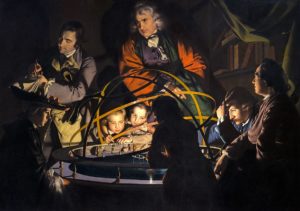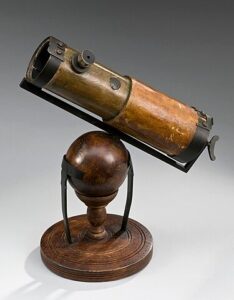 The New Discoveries
The New Discoveries
Once science had a solid and reliable foundation, as we explained in Lesson 12, new discoveries exploded into the world. One by one, we’re going to examine the most fundamental of them.
Light, Lenses, Microscopes and Telescopes
Light has always been an obvious and important subject, but people didn’t understand how it actually worked until the 17th century. And the man who put some of the most important pieces together was Isaac Newton, one of the greatest scientists ever.
People had long observed colors at the sharp edges of cut glass. Newton took this phenomenon and examined it closely (according to Bacon’s model), using prisms. What he found was that light entered a prism at one angle and left at another, and that when it did, it separated into a rainbow of colors. Like this:

Seeing that, Newton concluded that white light was composed of many colors, and by using a second prism, he found that the colored light remained as it was and could not be divided further. That meant that the light we normally see is not simply “white,” as we call it, but a range of colors all mixed together.
Newton used these facts to invent a much better type of telescope. Previously people had taken what they knew from magnifying glasses and learned to use more than one, in a single tube. That allowed scientists like Galileo Galilei to examine the moon and other planets, but it was difficult to go further with them, partly because the images kept getting distorted, with rainbow effects at the edges and with blurring from the separations of the colors. Newton realized that glass lenses would always have these effects, but that a curved mirror wouldn’t, because light bounced off of it rather than traveling through it.
Here’s a replica of Newton’s reflecting telescope (which he presented to the Royal Society in 1668), and a diagram of how light moved through it:

 The change in direction of light in a prism, the deflection of light, is called refraction, and it’s what causes a straw to look cut or deflected in a glass of water. What was learned is that light slows down in glass or water, which causes the change of direction. You can see it very clearly in this image:
The change in direction of light in a prism, the deflection of light, is called refraction, and it’s what causes a straw to look cut or deflected in a glass of water. What was learned is that light slows down in glass or water, which causes the change of direction. You can see it very clearly in this image:
 To grasp how this happens, imagine a truck going, at an angle, from a paved road, across a muddy field, then back onto pavement. As it hits the mud, only one tire will be on the mud; that will begin to slow the truck down, turning it. Once more wheels are on the mud the truck will continue in a straight line, but more slowly. Then, once the truck reaches the pavement on the other side, one tire will reach the pavement first and will speed up (moving with less resistance) turning the the truck the opposite way. And once wheels are on the pavement, it will continue onward at full speed.
To grasp how this happens, imagine a truck going, at an angle, from a paved road, across a muddy field, then back onto pavement. As it hits the mud, only one tire will be on the mud; that will begin to slow the truck down, turning it. Once more wheels are on the mud the truck will continue in a straight line, but more slowly. Then, once the truck reaches the pavement on the other side, one tire will reach the pavement first and will speed up (moving with less resistance) turning the the truck the opposite way. And once wheels are on the pavement, it will continue onward at full speed.
Refraction is what allows us to use curved glass – lenses – to make rays of light converge or diverge.
People had known for some time how to make eyeglasses, magnifying glasses and so on, but they didn’t know how glass affected light in that way. Now they did, which allowed them to use light and glass more intelligently.
You may hear people say that the speed of light is constant (at about 300,000 kilometers per second), but that’s true only for light in a vacuum, not as it passes through a material. Within the material, it proceeds more slowly.
What a telescope does, is to put the image of a small section of the sky a mere inch or so from your eye. That means that your retina, the back part of your eye that actually senses images, will be completely filled with the image of a star or planet. Looking at the star without a telescope, only a tiny part of your retina would receive any light from it.
Lenses were also used to examine very small things. The instrument used to see them was a microscope, and it works in almost the same way, filling your retina with the image of a very small thing.
Microscopes showed that far more was happening at the smallest levels than had been imagined. The things we saw with our unaided eyes, people learned, were full of strange and terribly small things. Water, shockingly, was found to be the home of tiny micro-organisms… living creatures so small that our eyes cannot see them. Blood was found to be composed of small red and white cells, and so on.
Both microscopes and telescopes revolutionized how people thought of the world. Suddenly the larger universe could be seen far better than ever before, and it turned out to be very different than they had thought. At the same time, the smaller universe could be seen far better than ever before, and it also turned out to be very different than they had thought.
Antony van Leeuwenhoek of the Netherlands been building microscopes in the back of his fabric shop, then began publishing drawings of what he saw through them in 1673. Robert Hooke of London had been using microscopes at the same time, though his lenses were never as good as van Leeuwenhoek’s. Hooke began making sense of all these discoveries, and did many other things besides.
Modern biology really begins with the microscope, and a good deal of modern medicine as well.
**
Paul Rosenberg
freemansperspective.com
